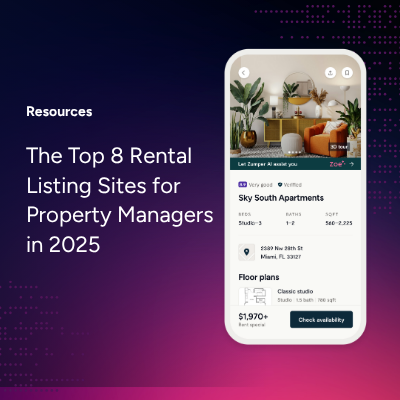
Landlords and renters begin most rental agreements by verbally discussing their terms and conditions, but these agreements should go beyond the spoken word alone. Creating a written simple rental agreement can help protect your property and your rights as a landlord.
What is a simple rental agreement?
A simple rental agreement is a straightforward document allowing an individual to use your property in exchange for rent for an agreed-upon period. You can use a simple rental agreement form to create an arrangement between you, the landlord, and a renter.
A very simple lease agreement will outline the terms and conditions of a tenancy and the landlord and renter’s rights and obligations. You can use a rental contract for either a fixed-term lease or a month-to-month agreement. You’ll typically include general terms such as the start and end date of the lease term, monthly rent, and utility responsibilities.
You should use a simple rental lease document only for residential properties. Examples of residential properties include the following:
- Apartments
- Condos
- Duplexes
- Houses
- Townhouse
These forms usually will not include required state disclosures. You’ll also need to attach a lead-based paint disclosure if you’re renting a housing structure built before 1978.
Why do you need a rental agreement?
Even if you create an agreement with simple terms, having a written and signed document is a vital step in the rental process. A simple lease contract protects you if problems or disputes arise during the term of the lease. You can use this document to resolve potential issues by reviewing and referring to the signed agreement when necessary since it is a binding agreement.
A basic rent agreement form also gives you a tool for communication with a prospective renter. You can go through the terms you both agree on and ensure that you and the renter have a mutual understanding when the lease term begins.
Terms to Include in a Simple Rental Agreement
A basic apartment rental agreement, for example, should cover several important details, such as the following:
- Names and contact information: List your name and contact details as the landlord and the name and details of the renter(s). You should include names of all adults if more than one person rents from you.
- Property address: Write the full address of the premises.
- Exact dates and terms of the lease: List the lease’s start date and end date or note that the lease functions on a month-to-month basis.
- Rent details: Include rent amount, monthly due date, and the landlord’s preferred payment method. You can also include details about late fees and penalties.
- Security deposit details: If you require the renter to pay a security deposit, you should include information on the amount and payment method. Emphasize that you will return the deposit at the end of the lease unless the renter causes property damage. Check local and state laws for security deposits to ensure you stay in compliance with these regulations.
- Maintenance and rules: Include details about the renter’s responsibilities, available appliances and their current condition, and any rules about alterations to the property.
- Subleasing clause: Include a clause specifying whether you will allow the renter to sublet the unit and any rights you want to retain for screening subtenants before finalizing an agreement.
- Concealed defect warning: You must inform renters about any existing defects to the property. This disclosure helps to avoid legal problems later on. However, you should repair defects before renting the property if at all possible.
- Termination statement: You can include details about how many days a renter may remain on the property if the individual does not intend to renew the rental agreement and outline specifications about your termination notice. Make sure you double-check local and state regulations about termination requirements as well.
- Pets: Clarify whether you allow pets. If you allow renters to have pets, you can set rules about pets in this basic agreement.
Basic Rental Agreement Template
You can use the following blank simple lease agreement as a basis for creating a simple rental agreement with your renters:
The Renter(s) known as [Name(s) of Renters] hereby agree to rent the dwelling located at [Address of Your Property]. Only the Renter(s) named above may occupy the premises. Renters may not sublet the premises.
- Term: Term shall commence on [Start Date], at $___ per month payable on the [first or other agreed-upon day] of each month in full. Term shall end on [End Date] OR Term shall continue on a month-to-month basis.
- Late Fees: Renter agrees to pay a late fee of $___ in the event Renter does not pay rent by the [fifth or other agreed-upon day] day after rent due date.
- Utilities: Renter must pay the following utilities: [electric, gas, water, etc.]
- Appliances: Appliances provided in the rental unit are: [stove, washing machine, refrigerator, etc.] Renters are responsible for repairs for any damage to the appliances caused by Renter negligence.
- Security deposit: Security deposit in the amount of $____ is due upon lease execution. Landlord shall hold Security Deposit until Renters have vacated the property and Landlord has inspected the property for damages.
- Insurance: Renter agrees to obtain a renter’s insurance policy and will provide Landlord with a copy of the policy within [number of days] of lease execution.
- Notices: Renter must provide [number of days] written notice to Landlord if Renter decides to vacate the property. Landlord must provide [number of days] written notice to Renter if Landlord decides to vacate Renter(s) from the property.
- Acknowledgment: Renter hereby acknowledges that the individual has read, understood, and agrees to all parts of this document and has received a copy of this document.
[DATE]
[Landlord Signature]
[Landlord Name], Landlord
[DATE]
[Renter Signature]
[Renter Name], Renter
A simple rental agreement will lay the foundation for a positive relationship with a renter built on mutual understanding. Having a signed binding agreement will also protect you if disputes arise.



